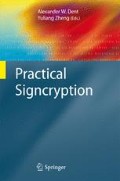Abstract
The first practical public-key encryption scheme and digital signature scheme were proposed in 1978 by Rivest et al. [165]. While the original public-key encryption scheme would not be considered secure by modern standards, the RSA transform has been the basis of dozens of public-key encryption schemes and digital signature schemes. These schemes have proven very successful and have been very widely deployed in industry. However, despite being widely used in the design of public-key encryption and digital signature schemes, the RSA transform has not been widely used in the construction of signcryption schemes.
Access this chapter
Tax calculation will be finalised at checkout
Purchases are for personal use only
References
M. Bellare and P. Rogaway. Random oracles are practical: A paradigm for designing efficient protocols. In Proceedings of the 1st ACM Conference on Computer and Communications Security, pages 62–73. ACM Press, 1993.
M. Bellare and P. Rogaway. Optimal asymmetric encryption. In A. De Santis, editor, Advances in Cryptology – Eurocrypt ’94, volume 950 of Lecture Notes in Computer Science, pages 92–111. Springer, 1994.
M. Bellare and P. Rogaway. The exact security of digital signatures—how to sign with RSA and Rabin. In U. Maurer, editor, Advances in Cryptology – Eurocrypt ’96, volume 1070 of Lecture Notes in Computer Science, pages 399–416. Springer, 1996.
J.-S. Coron, M. Joye, D. Naccache, and P. Paillier. Universal padding schemes for RSA. In M. Yung, editor, Advances in Cryptology – Crypto 2002, volume 2442 of Lecture Notes in Computer Science, pages 226–241. Springer, 2002.
Y. Dodis, M. J. Freedman, S. Jarecki, and S. Walfish. Optimal signcryption from any trapdoor permutation. Available from http://eprint.iacr.org/2004/020, 2004.
Y. Dodis, M. J. Freedmen, S. Jarecki, and S. Walfish. Versatile padding schemes for joint signature and encryption. In Proceedings of the 11th ACM Conference on Computer and Communications Security – ACM CCS 2004, pages 344–353. ACM Press, 2004.
A. K. Lenstra. Key lengths. In H. Bidgoli, editor, Handbook of Information Security. Wiley, 2005.
J. Malone-Lee and W. Mao. Two birds one stone: Signcryption using RSA. In M. Joye, editor, Topics in Cryptology – CT-RSA 2003, volume 2612 of Lecture Notes in Computer Science, pages 211–225. Springer, 2003.
A. May. Computing the RSA secret key is deterministic polynomial time equivalent to factoring. In M. Franklin, editor, Advances in Cryptology – Crypto 2004, volume 3152 of Lecture Notes in Computer Science, pages 213–219. Springer, 2004.
R. L. Rivest, A. Shamir, and L. Adleman. A method for obtaining digital signatures and public-key cryptosystems. Communications of the ACM, 21(2):120–126, 1978.
R. L. Rivest and R. B. Silverman. Are ‘strong’ primes needed for RSA? Available from http://eprint.iacr.org/2001/007, 1999.
R. Steinfeld and Y. Zheng. A signcryption scheme based on integer factorization. In J. Pieprzyk, E. Okamoto, and J. Seberry, editors, Information Security Workshop (ISW 2000), volume 1975 of Lecture Notes in Computer Science, pages 308–322. Springer, 2000.
Y. Zheng. Identification, signature and signcryption using high order residues modulo an RSA composite. In K. Kim, editor, Public Key Cryptography – PKC 2001, volume 1992 of Lecture Notes in Computer Science, pages 48–63. Springer, 2001.
Author information
Authors and Affiliations
Corresponding author
Editor information
Editors and Affiliations
Rights and permissions
Copyright information
© 2010 Springer-Verlag Berlin Heidelberg
About this chapter
Cite this chapter
Dent, A.W., Malone-Lee, J. (2010). Signcryption Schemes Based on the RSA Problem. In: Dent, A., Zheng, Y. (eds) Practical Signcryption. Information Security and Cryptography. Springer, Berlin, Heidelberg. https://doi.org/10.1007/978-3-540-89411-7_6
Download citation
DOI: https://doi.org/10.1007/978-3-540-89411-7_6
Published:
Publisher Name: Springer, Berlin, Heidelberg
Print ISBN: 978-3-540-89409-4
Online ISBN: 978-3-540-89411-7
eBook Packages: Computer ScienceComputer Science (R0)

